
Browse an alphabetical list of photographs. These historical images portray people, places, and events before, during, and after World War II and the Holocaust.
<< Previous | Displaying results 1151-1200 of 2641 for "Photo" | Next >>
Harry teaching granddaughter Alexis Danielle how to swim, probably in San Diego, California.
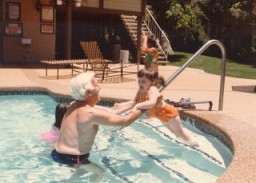
Hartheim castle, a euthanasia killing center where people with physical and mental disabilities were killed by gassing and lethal injection. Hartheim, Austria, date uncertain.
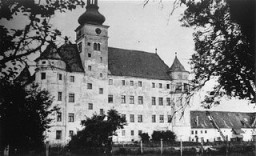
Haviva Reik before her emigration to Palestine. Banska Bystrica, Czechoslovakia, 1934. Between 1943 and 1945, a group of Jewish men and women from Palestine who had volunteered to join the British army parachuted into German-occupied Europe. Their mission was to organize resistance to the Germans and aid in the rescue of Allied personnel. Reik was one of these parachutists. She parachuted into Slovakia and was captured and killed in November 1944.

Head nurse of the children's ward at the Kaufbeuren-Irsee euthanasia facility. Kaufbeuren, Germany, 1945.
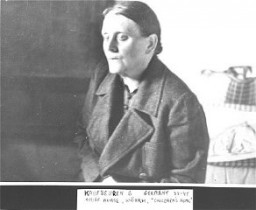
Dr. Horowitz's Hebrew class at Jefferson High School, Brooklyn, New York, 1947. (Regina is in top row, third from right, Professor Horowitz is in front row, third from right.)
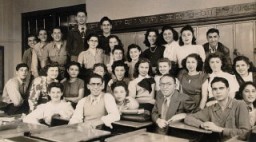
SS chief Heinrich Himmler (left) and Hans Frank, head of the Generalgouvernement in occupied Poland. Krakow, Poland, 1943.
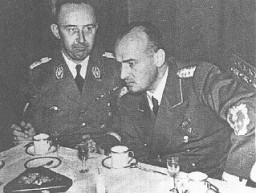
SS chief Heinrich Himmler (front row, left) and Mauthausen commandant Franz Ziereis (second from left) inspect inspect the Wiener Graben quarry during an official tour of the Mauthausen concentration camp. Austria, April 27, 1941.
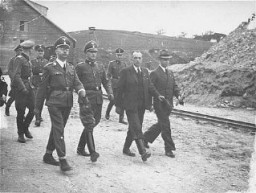
Heinrich Himmler, head of the SS, speaks to an inmate of the Dachau concentration camp during an official inspection. Dachau, Germany, May 8, 1936.
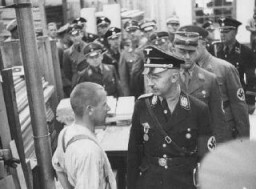
SS chief Heinrich Himmler reviews a unit of SS-police in Krakow, Poland, March 13, 1942.
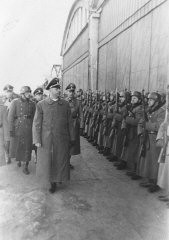
Heinrich Himmler (seated, center), chief of the SS, with Reinhard Heydrich (standing, left), chief of the Security Police and SD. Berlin, Germany, 1938.

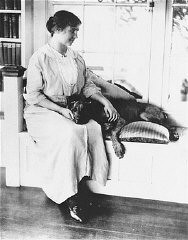
Portrait of Helen Keller, ca. 1910. In 1933, Nazi students at more than 30 German universities pillaged libraries in search of books they considered to be "un-German." Among the literary and political writings they threw into the flames were the works of Helen Keller.
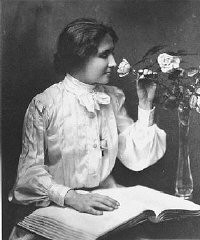
In this portrait, Helena Husserlova, wearing a Jewish badge, poses with her daughter Zdenka who is holding a teddy bear. The photograph was taken shortly before they were deported to Theresienstadt. Zdenka was born in Prague on February 6, 1939. On October 10, 1941, when Zdenka was just two and a half years old, her father was deported to the Lodz ghetto. He died there almost a year later, on September 23, 1942. Following his deportation, Helena and Zdenka returned to Helena's hometown to live with…
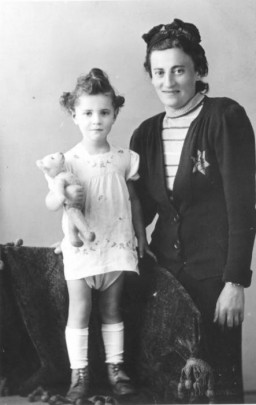
American novelist Ernest Hemingway on safari, ca. 1933. In 1933, Nazi students at more than 30 German universities pillaged libraries in search of books they considered to be "un-German." Among the literary and political writings they threw into the flames were the works of Ernest Hemingway.

In 1942, Henrietta and Herman Goslinski went into hiding to avoid deportation from the Netherlands. Their rescuer could not, however, also take their infant daughter Berty. The Dutch resistance moved Berty frequently; she was eventually moved more than 30 times. During the two-and-a-half years apart, the parents saw Berty only once and received this single photograph of her taken while she was in hiding.
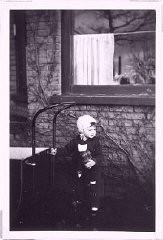
Henrietta Szold (left, in hat), founder of the Hadassah Women's Zionist Organization, welcomes some of the Polish Jewish refugee children known as the Tehran Children, upon their arrival in Palestine. Atlit, Palestine, February 18, 1943.
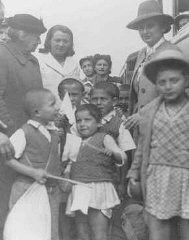
Henry Morgenthau, Jr., treasury secretary in the Roosevelt administration and later chairman of the United Jewish Appeal, greets Jewish refugees en route from Shanghai to Israel. New York, United States, March 2, 1949.

Henry Morgenthau, Jr., testifies before the Senate Foreign Relations Commission in support of the Lend-Lease bill to aid Britain. Morgenthau was secretary of the treasury under President Franklin D. Roosevelt. Lend-Lease was the name of the US policy of extending material aid to the Allies before and after the United States entered World War II.
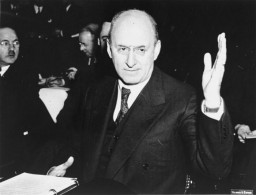
Hermine Orsi sheltered a number of Jews in her home and helped others reach refuge in Le Chambon-sur-Lignon. Yad Vashem recognized her as "Righteous Among the Nations." Marseille, France, 1940.
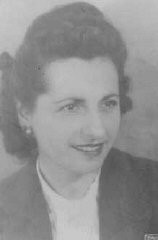
Herta Oberheuser was a physician at the Ravensbrück concentration camp. She performed medical experiments. She was found guilty of performing sulfanilamide experiments, bone, muscle, and nerve regeneration and bone transplantation experiments on humans, as well as of sterilizing prisoners. This portrait of Herta Oberheuser was taken when she was a defendant in the Medical Case Trial at Nuremberg.
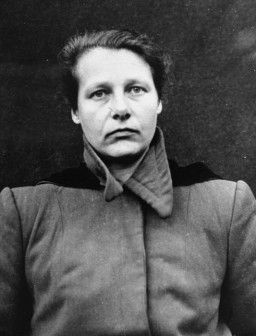
HIAS immigration certificate issued to Manius Notowicz in Munich, Germany. The document states that Notowicz will travel on the Marine Flasher on February 22, 1947, to New York City.
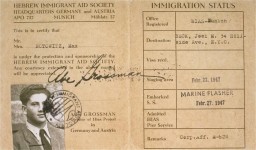
During a roundup for deportation in eastern Poland in 1942, Gitta Rosenzweig—then three or four years old—was sent into hiding. She ended up in a Catholic orphanage. In 1946, Ida Rosenshtein, a family friend and a survivor, learned of the child's whereabouts and sought to claim her. After denying that it held a Jewish child, the orphanage relinquished custody after Ida recognized Gitta and a local Jewish committee paid a "redemption" fee. Gitta is pictured here on the day she left the orphanage.
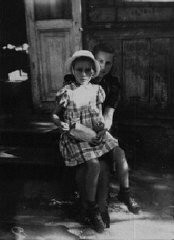
Jewish child Hans van den Broeke (born Hans Culp) in hiding in the Netherlands. He is 2 years old in this photograph.
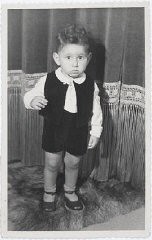
An Italian Jew who survived the war by disguising himself as a priest and living in the Vatican from October 1943 to June 1944. A number of Jews were able to seek refuge in religious houses throughout Rome, including in the Vatican. Rome, Italy, 1943-1944.
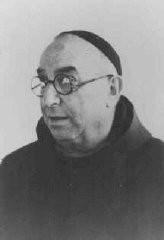
Two Jewish men captured by the SS pull a woman from an underground bunker during the suppression of the Warsaw ghetto uprising. Warsaw, Poland, May 8, 1943.
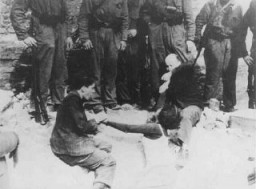
Some Jewish children survived the Holocaust because they were protected by people and institutions of other faiths. Children quickly learned to master the prayers and rituals of their "adopted" religion in order to keep their Jewish identity hidden from even their closest friends. This photograph shows two hidden Jewish children, Beatrix Westheimer and her cousin Henri Hurwitz, with Catholic priest Adelin Vaes, on the occasion of Beatrix's First Communion. Ottignies, Belgium, May 1943.
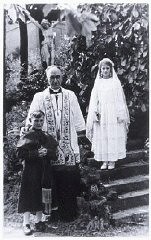
Hieronim Sabala (known as "Flora"), a member of the "Gray Columns" (code name for the underground scouts of the Polish resistance movement). Warsaw, Poland, 1939.
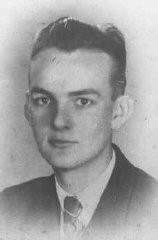
The defendants in the dock (right) and their lawyers (center) listen to trial proceedings during the High Command Case.
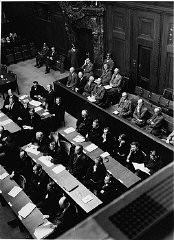
SS chief Heinrich Himmler leads an inspection of the Mauthausen concentration camp. Austria, April 27, 1941.
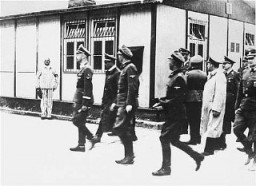
Hinda Eidenberg (center) stands outdoors in a field with her child and her niece. Pictured from right to left are: Sabina Weinstock (Hinda's niece), Hinda Eidenberg, and Hinda's child. Hinda and her child later perished in the Trawniki camp. Photograph taken in Kozienice, Poland, 1940.
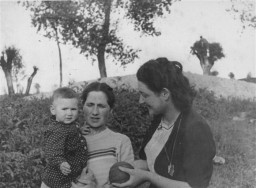
Hitler addresses German troops at the market square in Eger, during the German occupation of Czechoslovakia's Sudetenland region. October 3, 1938.
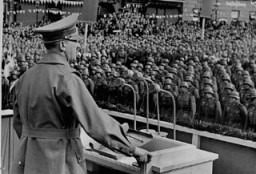
Adolf Hitler and Joseph Goebbels sign autographs for members of the Canadian figure skating team at the Winter Olympic Games. Garmisch-Partenkirchen, Germany, February 1936.
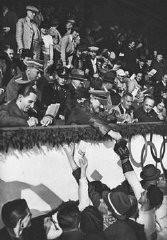
Axis leaders Adolf Hitler and Italian prime minister Benito Mussolini meet in Munich, Germany, 1940.
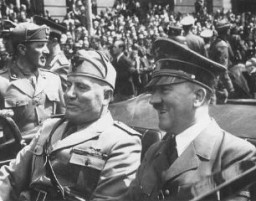
Adolf Hitler and his personal architect, Albert Speer, in Paris shortly after the fall of France. Paris, France, June 23, 1940.
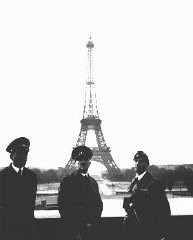
An enthusiastic crowd greets Adolf Hitler upon his arrival at the Olympic Stadium. Berlin, Germany, August 1936.
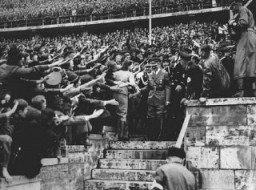
Hitler enters Memel following the German annexation of Memel from Lithuania. The banner states that "This land will remain forever German." Memel, March 1939.
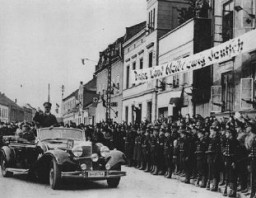
Adolf Hitler (hand on rail) with Hermann Göring (second to left of Hitler) and Joseph Goebbels (third to left of Hitler) at the site of the fire that damaged the Reichstag (German parliament) building. Berlin, Germany, February 1933.
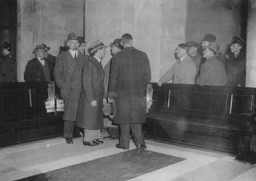
Adolf Hitler in Brno shortly after German troops occupied Czechoslovakia. The sign reads, "We thank our Führer." Brno, Czechoslovakia, March 17, 1939.
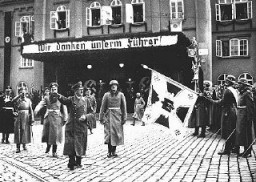
Hitler inspects a German naval warship. On his left is Admiral Erich Raeder. Standing to the right of Hitler is most likely Captain Hermann von Fischel, commander of the Deutschland from April 1, 1933, to December 29, 1935. Bremerhaven, Germany, circa 1933–1935.
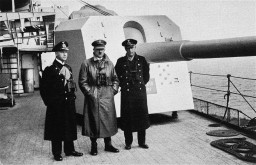
Hitler carefully cultivated his image as the Nazi Party leader as he came to see the propagandistic value of photographic publicity. Heinrich Hoffmann, Hitler’s official photographer, created the images central to the growing "Führer cult." In 1927, Hoffmann snapped action shots such as this one of Hitler rehearsing his oratory.

Adolf Hitler, Julius Streicher, and other dignitaries review passing Nazi Party members at the Deutscher Tag (German Day) celebration in Nuremberg, September 02, 1923.
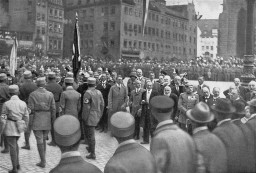
Adolf Hitler reviews SA troops celebrating the third anniversary of his assumption of power. Berlin, Germany, February 20, 1936.
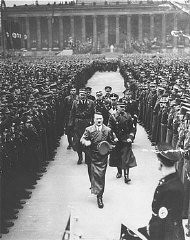
Hitler during a triumphal tour of the Sudetenland following the Munich agreement of September 1938. The agreement ceded the largely German-speaking Sudeten region of Czechoslovakia to Germany. Eger, Czechoslovakia, October 3, 1938.
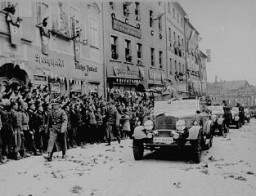
Hitler Youth members listen to a speech by Adolf Hitler at a Nazi "party day" rally. Nuremberg, Germany, September 11, 1935.
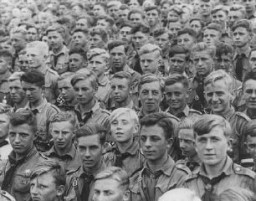
At a rally, members of the Hitler Youth parade in the formation of a swastika to honor the Unknown Soldier. Germany, August 27, 1933.
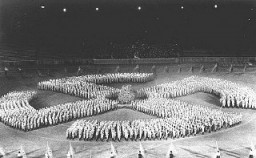
Scene during Adolf Hitler's triumphant return to Berlin shortly after Germany's annexation of Austria (the Anschluss). Berlin, Germany, March 17, 1938.
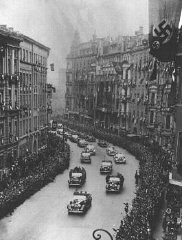
This picture, taken in 2004, shows Blanka Rothschild holding one of her prewar family photographs.
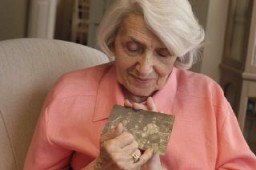
Members of a Polish family perform daily chores amidst the amidst the charred ruins of their home, destroyed during the German bombing of Warsaw. They have reassembled the remnants of their household furnishings outside. Photographed by Julien Bryan, circa 1939.
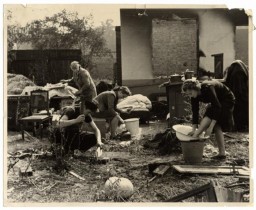
A private Jewish home vandalized during Kristallnacht (the "Night of Broken Glass" pogrom). Vienna, Austria, November 10, 1938.
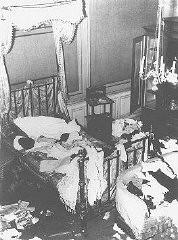
A private Jewish home vandalized during Kristallnacht (the "Night of Broken Glass" pogrom). Vienna, Austria, November 10, 1938.
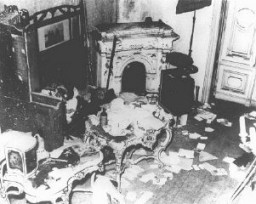
We would like to thank Crown Family Philanthropies, Abe and Ida Cooper Foundation, the Claims Conference, EVZ, and BMF for supporting the ongoing work to create content and resources for the Holocaust Encyclopedia. View the list of donor acknowledgement.